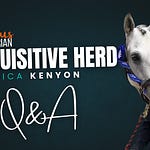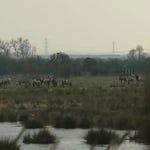Is one of the most overlooked areas is the relationship between the environment horses live in and their overall welfare. As horse owners, we often focus on training, nutrition and veterinary care, but what about the land itself? How does the state of our paddocks and pastures influence our horses' happiness and health?
In this episode we Anna Louise and Annabelle Holmes, an equine ecologist explore these questions.
What Is an Equine Ecologist?
Annabelle Holmes is a pioneer in a unique field known as equine ecology, which combines her lifelong passion for horses with her academic background in ecology. Essentially, an equine ecologist helps horse owners understand the complex interactions between their horses and the land they occupy, offering practical advice on how to manage paddocks in ways that benefit both the horse and the environment.
"Equine ecology is about marrying scientific knowledge with real-life application," Holmes explained in our interview. "Many horse owners don't have time to study ecology or animal behaviour in depth, but they want to do the right thing by their horses and the environment. This is where an equine ecologist steps in, to tailor land management strategies specific to the needs of the horses and the particular characteristics of the land."
Not yet part of our Inquisitive Herd? Above you'll find a 1-minute preview of our conversation with Annabelle Holmes. Join our community today to watch the complete interview ad-free and access our library of exclusive content on sustainable horse care.
Or watch free with ads on our YouTube Channel
Conservation Grazing: Horses as Land Managers
Contrary to the common perception that horses might damage land, certain breeds of hardy native ponies are excellent at managing vegetation and maintaining biodiversity.
"For example, Exmoor ponies and feral Welsh ponies are used in rewilding projects and nature reserves to control invasive plants like bracken," Holmes told us. "Horses trample and graze bracken, which tends to spread quickly and dominate landscapes, while sheep complement this by nibbling on plants horses avoid. This cooperative grazing helps maintain rare habitats and promotes a healthy ecosystem."
These examples challenge the stereotype that horses are harmful to land and demonstrate their potential role in sustainable land management.
Changing Perceptions: Horses and Land Health
Despite their benefits, horses often carry a bad reputation among landowners and farmers, who worry about soil compaction and poaching. The real issue, Holmes points out, lies in how horses are currently managed rather than the horses themselves.
"Many horse owners simply turn their horses out in a paddock without considering the consequences for the soil, plants, or even the horses' nutrition," she shared. "Overgrazing, lack of rotation, and unmanaged bare ground lead to soil degradation, weed invasion, and nutrient imbalances. Horses tend to congregate in certain areas, creating nutrient hotspots from their droppings, while overgrazing other patches."
To change this perception, horse management must evolve. This involves adopting practices such as rotating paddocks to allow grass to recover, managing bare ground carefully, and balancing grazing pressure. These efforts not only protect the land but ultimately improve horse welfare.
Practical Tips for Sustainable Paddock Management
For horse owners eager to make a positive difference, Holmes offers actionable advice:
Rotate Paddocks: Allow grass to rest and regrow by moving horses between different areas. This reduces stress on the grass, lowers sugar production in plants, and prevents soil compaction.
Manage Bare Ground: Bare patches are vulnerable to weed invasion and soil erosion. Use agricultural methods or introduce certain plants that suppress weeds and encourage biodiversity.
Encourage Plant Diversity: Instead of relying solely on ryegrass and clover, which can be high in sugar and less beneficial, introduce a variety of native grasses and plants suited to your local environment.
Provide Enrichment: Horses naturally forage and explore. Taking them for hedgerow walks or adding browsing plants within paddocks can stimulate natural behaviours and improve mental wellbeing.
Holmes emphasises the importance of tailoring these strategies to individual land conditions and horse needs rather than following a one-size-fits-all approach.
Adapting to Weather and Climate Change Challenges
This year's unpredictable weather patterns have made land management even more challenging. Wet springs and summers lead to lush grass growth in some areas but cause bare patches and poor growth in others. Holmes stresses that these conditions are a direct result of climate change, and adapting to them is essential.
"Natural grasslands, with their diverse plant species adapted to local conditions, are more resilient to weather extremes than improved pastures dominated by a few high-yield grass species," she explained. "Such diversity not only protects the soil but also helps sequester carbon, contributing to climate change mitigation."
Horse owners can support this by fostering biodiversity in their paddocks and moving away from intensive, monoculture-style grass management.
Choosing and Managing Grass Species for Health and Vitality
The choice of grass species in paddocks plays a crucial role in horse health and environmental sustainability. Holmes recommends focusing on native species adapted to your region rather than generic "off-the-shelf" mixtures that often contain ryegrass and clover.
"Fescues, for example, are a group of grasses that tend to be hardy and beneficial," she noted during our conversation. "Consulting local wildlife trusts or ecological resources can help identify which species are best suited to your area."
Changing grass species can be a significant undertaking, especially if your land is dominated by aggressive pasture grasses. Holmes advises starting small and considering gentle methods such as selective grazing or planting companion species rather than aggressive ploughing or chemical treatments.
Enriching Paddocks Naturally
Beyond grass, paddock enrichment can significantly enhance a horse's experience and wellbeing. Holmes suggests simple, natural ways to do this:
Introduce hedgerows or living fences around paddocks to provide shelter, shade, and browsing opportunities.
Create small browsing gardens with safe herbs and plants that horses can choose from.
Take horses on short foraging walks to encourage natural grazing behaviour and exercise.
While commercial enrichment toys like balls and swinging tools can be useful, especially for horses in stables or on restricted turnout, the landscape itself offers abundant natural enrichment that supports both mental and physical health.
Observing Horse Behaviour for Welfare Assessment
Understanding how horses interact with their environment is key to assessing their welfare. Holmes highlights some signs to watch for:
Red Flags: Behaviours like biting, bolting, or aggression may indicate distress and warrant veterinary or behavioural consultation.
Subtle Signs: Chewing fence lines, pacing, or creating muddy patches along fences can signal boredom or stress.
Signs of Happiness: Relaxed posture, mutual grooming in herds, playful behaviour, and the ability to lie down and sleep comfortably are all positive indicators.
Taking time to simply observe horses in their environment—standing quietly in the field or walking alongside them—can provide valuable insights into their wellbeing.
Alternatives to Traditional Paddocks: Track Systems and Beyond
Traditional square or circular paddocks don't always meet horses' natural needs for movement and variety. Track systems, which became more popular in the UK around 2017, are designed to encourage more natural movement patterns by creating a circular or oval path around a central area.
Holmes supports such innovations but also encourages horse owners to mix and match different approaches. "For example, aquaculture principles, nurturing soil health and biodiversity, can be combined with track systems or more traditional grazing management," she suggested.
Flexibility and adaptation are critical, and horse owners should feel empowered to experiment with what works best for their land and horses.
Balancing Horse Welfare and Environmental Sustainability
At the heart of Holmes's approach is the belief that horse welfare and environmental health are not mutually exclusive but deeply interconnected. By creating environments that mimic natural conditions: open spaces, diverse vegetation, varied terrain, horses thrive physically and mentally, and the land remains healthy and resilient.
For instance, natural grazing behaviour reduces the risk of metabolic issues by allowing horses to select a variety of plants rather than being confined to a sugary ryegrass pasture. Diverse habitats also provide shelter and enrichment, supporting psychological wellbeing.
Managing Common Challenges: Ragwort and Weeds
One of the most contentious plants in horse paddocks is ragwort, a poisonous weed that many owners strive to eradicate. Holmes acknowledges the risks but advocates for a balanced approach. Complete eradication may not be feasible or even desirable for wildlife, as ragwort supports butterflies and other insects.
"Instead, managing ragwort by promoting healthy grass growth and preventing bare patches reduces its spread," she told us. "Horses generally avoid ragwort due to its bitter taste unless it's present in hay, where it poses a significant risk and should be removed."
Taking Baby Steps Toward Sustainable Land Management
Transitioning from conventional to eco-friendly land management can feel overwhelming, but Holmes recommends starting small. Focus on one paddock or section of land to experiment with new practices. Conduct botanical surveys, test soil health, and gradually introduce changes.
Education is key—learning about local plants, soil biology, and horse behaviour helps make informed decisions. And remember, progress takes time. Land restoration is a long game but yields lasting benefits for horses, owners, and the environment.
Success Stories and the Road Ahead
Though still early in her equine ecology career, Holmes has already contributed to projects that balance horse welfare with wildlife conservation. For example, she has worked with landowners to protect rare bird habitats while maintaining sufficient grazing. Her previous ecological consultancy involved relocating amphibians to safe habitats during housing developments, demonstrating the positive impact of thoughtful land stewardship.
Looking forward, Holmes aims to raise awareness through social media, podcasts, and public talks, encouraging horse owners and land managers to embrace sustainable practices. She also anticipates that future legislation and incentives may support better land management, making this a critical time for change.
Final Thoughts: Embracing Nature to Enhance Horse Happiness
Our horses' happiness and health depend not only on what we feed them or how we train them but also on the environment they inhabit. By fostering biodiversity, managing land sustainably, and allowing horses to express natural behaviours, we can create a harmonious relationship between horse and habitat.
Whether it's rotating paddocks, introducing native plants, enriching paddocks naturally, or simply spending time observing your horse in the field, every step counts. The journey toward eco-friendly equine care is both rewarding and essential for the future of our horses and the planet.
Thank you for being part of our Inquisitive Herd! We appreciate your support that allows us to create ad-free content like our interview with Annabelle Holmes. As a member, you can enjoy the full episode without interruptions and access our exclusive playlist of member-only extended interviews and bonus content.










